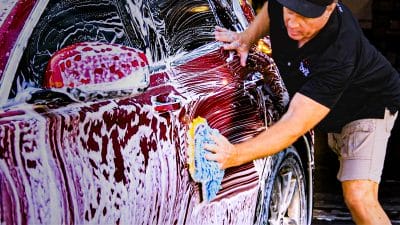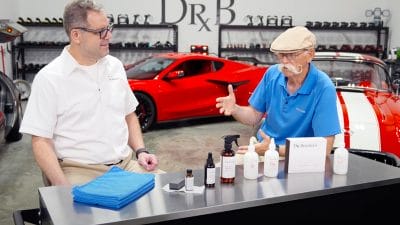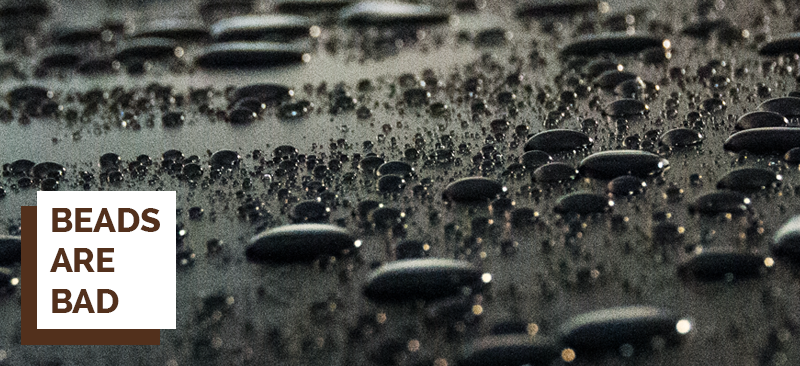Last Updated May 17, 2023
Beads are bad? What?
We know what you’re thinking: Water beading on hydrophobic (a.k.a. water repellent) coatings is amazing! It shows your paint is protected, makes it easier to dry, and it promotes self-cleaning. And above all else, it looks COOL.
Look, we get it. We’ve definitely sung beading’s praises before. We post beautiful beading shots to our Instagram; we talk about water contact angle on our product pages. But behind their beauty lies something far more sinister.
The truth is, immobile beads can be a threat to the health of your finish. Beads sitting idle on your paintwork form unsightly water spots that can etch permanently into the clear coat. They force you to dry more, leading you to inflict thousands of tiny little scratches with your towel. And that’s not even half of the harm they can do.
In order for beads to be beneficial, they need to be in motion. And in order to be in motion, multiple variables need to work together: sliding angle, gravity, advancing contact angle, receding contact angle… it’s complicated stuff.
Which is why ceramic coating manufacturers aren’t really talking about any of this. It’s kind of a heady subject; not easily marketable. The most they’ll do is talk about water contact angle, leading you to believe it’s the sole determination of water repellency. It’s not!
We’re here to set the record straight. Beads hurt your finish and can only help when they’re sliding off. Ceramic coating companies don’t focus on this enough and instead push a simplified misconception. Coating formulation needs to take this concept into account, which is why we make it a central feature of our nano technology.
Why Are Beads Bad?
As we mentioned earlier, it’s not that beads are inherently bad; that’d be ridiculous. Instead, it’s that static beads harm your paint, both directly and indirectly.
Water spots
Imagine a bead resting on a hood. Like any body of water, it slowly evaporates into the air. If the bead’s water has mineral content, that content will not evaporate with the rest of the water, instead remaining on the surface in the form of a stubborn residue. That residue is what’s commonly known as a water spot.
Leave a water spot to sit for long enough and the mineral content within will eat through your paint’s clear coat, resulting in a concave etch that’s impossible to remove without mechanical buffing. Anything that forces you to shave away at your already thin clear coat is NOT healthy for your paint.
Abrasion
Beads can also lead to scratches (a.k.a. micro-marring, wash marks) in you finish. Here’s how it happens: Beads sitting on your paint need to be dried, and microfiber towels are the most common way to dry. But even with the most plush microfiber towel in the world, you’re still abrading (rubbing up against) your coating, and that dramatically raises the chance of you scratching your paint.
Obviously a ceramic coating wouldn’t be removed by these tiny scratches, but your finish will look worse for wear. You’ll notice thousands and thousands of marks on your finish whenever your car’s under the sun. They’ll dull your coatings’ gloss, too. With these downsides in mind, what can be done to make water beading an advantage instead of a negative?
Making Water Beading Good
For beads to have any benefit, they need to be moving off your paint. So what takes hydrophobicity from static beads to moving ones? The sliding angle. This refers to the surface angle at which a bead starts to move. The lower your sliding angle, the easier it is for beads to roll off your paint.
Sliding angle
Talking about this concept is contrary to how coating brands frame hydrophobicity. Usually all they’ll mention is contact angle, implying that this metric is the sole determination of water repellency. But contact angle is only a static measure. A dynamic measure like sliding angle is what really tells you how easily a bead can leave your paint.
So what accounts for low sliding angle? There are several metrics at play, but at the most basic level the answer lies in the slickness of your paintwork. The more slick the surface, the more easily a bead can roll off.
Benefits of bead mobility
Once beads get moving, they give you a unique benefit: self-cleaning. Beads pick up and carry away contaminants as they roll. When it rains, you get a free car wash. And when you’re actually washing your car, water will sheet off easily and take gunk with it.
But if your beads remain static, none of this will happen. The most you’ll get is a cool shot for Instagram. Coating companies pretend high contact angles are what boosts this self-cleaning power, but it really all comes down to the sliding angle.
Why Isn’t Anyone Talking About This?
If sliding angle is the secret to harnessing the benefits of water beading, why isn’t it a more well-known concept? We could speculate all day, but the most obvious reason is marketing.
The contact angle myth
Since so much of water repellency revolves around science, it can get tough to talk about when you go into too much detail. Start speaking of sliding angle and surface lubricity and people’s eyes start glazing over. Your pitch just got a lot harder to make.
Keep it down to just hydrophobicity and contact angle, though, and marketing suddenly gets much easier. It’s similar to how scratch resistance gets boiled down to a number on the pencil hardness test, or chemical resistance to pH tolerance. But this simplification ends up creating a myth that water repellency is just about contact angle, obscuring other important measures like sliding angle.
Aesthetics over performance
Of course, it’s not just about simplifying a pitch. Aesthetics are at play, too. Ask yourself, what makes for a better picture: a beautiful, nearly circular bead with a sky-high contact angle, or a bare surface? The former, right? Even though the bare surface did a better job repelling the water, that beautiful sphere will win the beauty contest every time.
So, as expected, visual marketing trends towards static beads. This leads consumers to believe sexy, static beads are a net positive, and as such they stop paying attention to more pertinent performance metrics, like sliding angle.
Beading is easy; moving beads is hard
Beyond the marketing angles, beading is just plain easier to achieve than genuine water repellency. After all, hydrophobic paint protection is practically ancient history. Folks have been waxing lacquer and getting beads since the early 19th century.
Since then, water beading products have become dime a dozen. Anyone can source superhydrophobic ingredients; it takes strong chemical engineering skills and a drive for innovation to formulate a super-slick coating.
How Dr. Beasley’s Tech Gets Beads Moving
The health of a vehicle is central to Dr. Beasley’s detailing philosophy, so it’s no surprise we’re concerned about the danger of sitting beads. It’s our “do no harm” approach that mandates we formulate protective ceramic coatings for true, bead-moving water repellency.
And since bead mobility is determined by surface slickness, we obsessively formulate for the slickest surface possible. That means re-engineering your paint’s clear coat to achieve a nanostructure, painstakingly formulating until sliding angle is minimized to the greatest possible degree. This goes for all of our ceramic coatings; Nano-Resin, for example.

Nano-Resin is fundamentally designed to make water slide off. When it rains, water beads up and slides off. When you’re washing, water doesn’t even bead; it sheets off immediately and takes any dirt on the surface with it. That way, water spots, etching and drying-induced abrasion are minimized.
The Road Ahead
What you’ve just read barely scratches the surface of how static beads harm your finish, and what mobile beads do for it. In the months ahead, we’ll be covering all aspects of hydrophobicity, shedding light on an oft-overlooked concept.





Questions? Comments?
Email Us